When it comes to renting a room, having a clear and comprehensive Room Rental Agreement is essential for both landlords and tenants. This document outlines the terms and conditions of the rental arrangement, providing a solid foundation for a positive rental experience. Key aspects of the agreement include the rental amount, payment schedule, and security deposit requirements, ensuring that both parties understand their financial obligations. Additionally, the agreement typically covers the duration of the rental period, outlining start and end dates, as well as any renewal options. Important rules regarding property maintenance, utilities, and guest policies are also addressed, helping to prevent misunderstandings down the line. By clearly defining responsibilities and expectations, a well-crafted Room Rental Agreement fosters a respectful and harmonious living environment, protecting the rights of both the landlord and the tenant.
